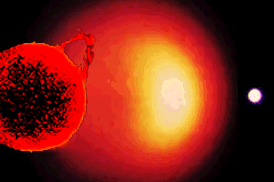White Dwarf Stars
A white dwarf is what stars like the Sun become after they have exhausted their nuclear fuel. Near the end of its nuclear burning stage, this type of star expels most of its outer material, creating a planetary nebula. Only the hot core of the star remains. This core becomes a very hot white dwarf, with a temperature exceeding 100,000 Kelvin. Unless it is accreting matter from a nearby star (see Cataclysmic Variables), the white dwarf cools down over the next billion years or so. Many nearby, young white dwarfs have been detected as sources of soft, or lower-energy, X-rays. Recently, soft X-ray and extreme ultraviolet observations have become a powerful tool in the study the composition and structure of the thin atmosphere of these stars.

A typical white dwarf is half as massive as the Sun, yet only slightly bigger than Earth. An Earth-sized white dwarf has a density of 1 x 109 kg/m3. Earth itself has an average density of only 5.4 x 103 kg/m3. That means a white dwarf is 200,000 times as dense. This makes white dwarfs one of the densest collections of matter, surpassed only by neutron stars.
What's inside a white dwarf?
Because a white dwarf is not able to create internal pressure (e.g. from the release of energy from fusion, because fusion has ceased), gravity compacts the matter inward until even the electrons that compose a white dwarf's atoms are smashed together. In normal circumstances, identical electrons (those with the same "spin") are not allowed to occupy the same energy level. Since there are only two ways an electron can spin, only two electrons can occupy a single energy level. This is what's known in physics as the Pauli Exclusion Principle. In a normal gas, this isn't a problem because there aren't enough electrons floating around to fill up all the energy levels completely. But in a white dwarf, the density is much higher, and all of the electrons are much closer together. This is referred to as a "degenerate" gas, meaning that all the energy levels in its atoms are filled up with electrons. For gravity to compress the white dwarf further, it must force electrons where they cannot go. Once a star is degenerate, gravity cannot compress it any more, because quantum mechanics dictates that there is no more available space to be taken up. So our white dwarf survives, not by internal fusion, but by quantum mechanical principles that prevent its complete collapse.
Degenerate matter has other unusual properties. For example, the more massive a white dwarf is, the smaller it is. This is because the more mass a white dwarf has, the more its electrons must squeeze together to maintain enough outward pressure to support the extra mass. However, there is a limit on the amount of mass a white dwarf can have. Subrahmanyan Chandrasekhar discovered this limit to be 1.4 times the mass of the Sun. This is appropriately known as the "Chandrasekhar limit."
With a surface gravity of 100,000 times that of Earth, the atmosphere of a white dwarf is very strange. The heavier atoms in its atmosphere sink, and the lighter ones remain at the surface. Some white dwarfs have almost pure hydrogen or helium atmospheres, the lightest of elements. Also, gravity pulls the atmosphere close around it in a very thin layer. If this occurred on Earth, the top of the atmosphere would be below the tops of skyscrapers.
Scientists hypothesize that there is a crust 50 km thick below the atmosphere of many white dwarfs. At the bottom of this crust is a crystalline lattice of carbon and oxygen atoms. Since a diamond is just crystallized carbon, one might make the comparison between a cool carbon/oxygen white dwarf and a diamond.
Last Modified: December 2010
Additional Links
- Quiz me about this topic
- Cool fact about this topic
- Try this!
- FAQs on white dwarfs and other stars
- Introductory level article on this topic.
- Give me additional resources


